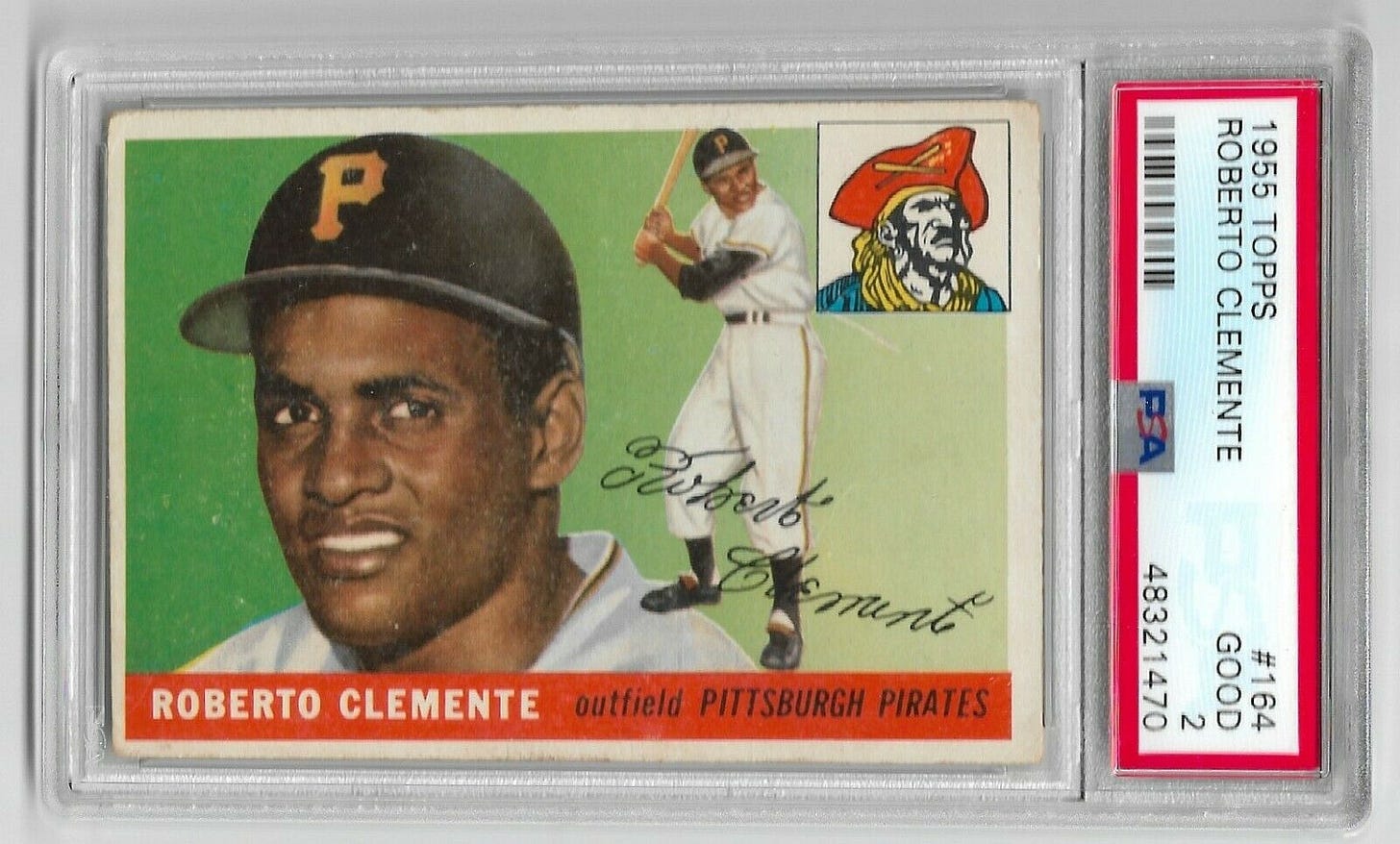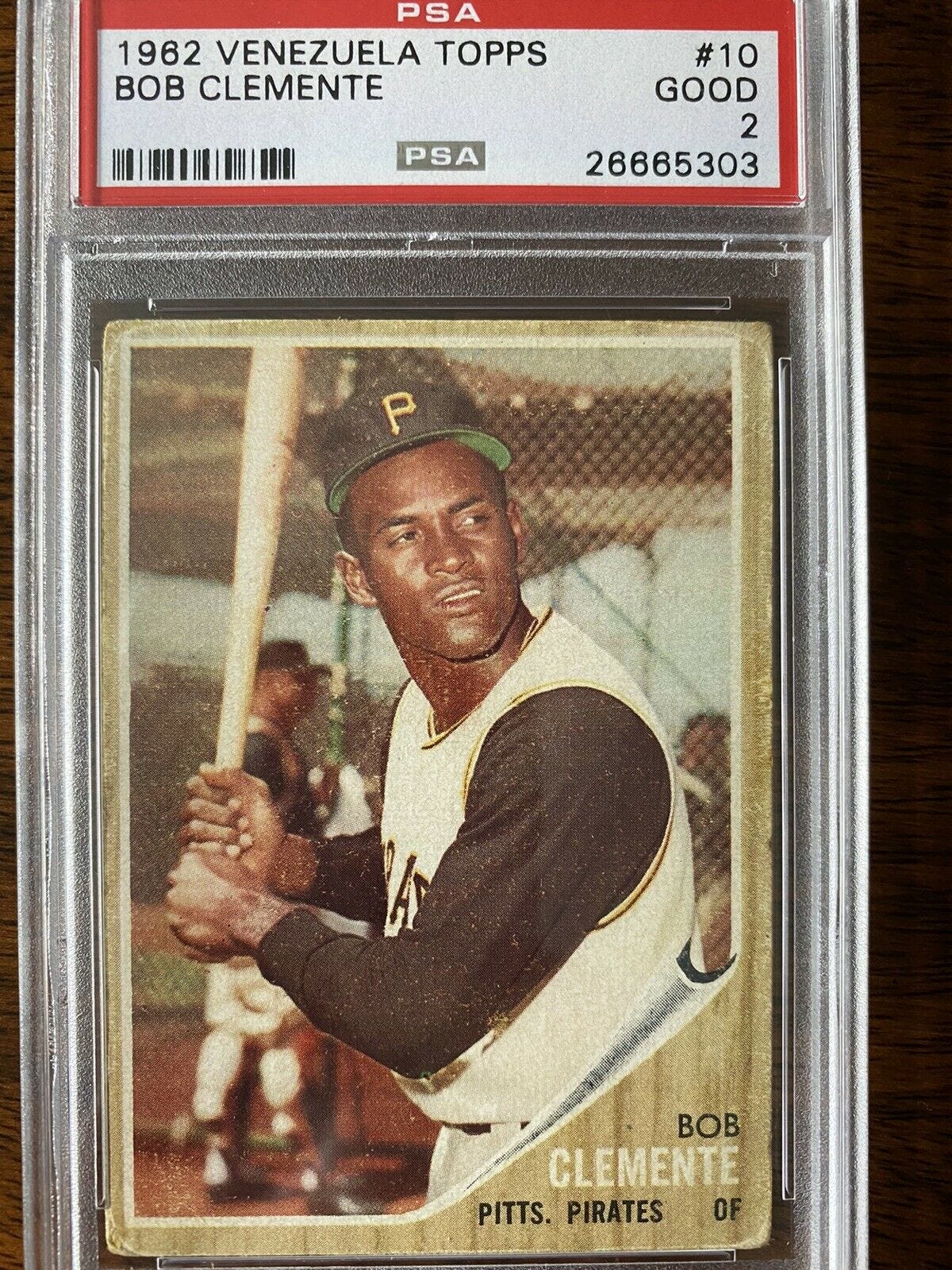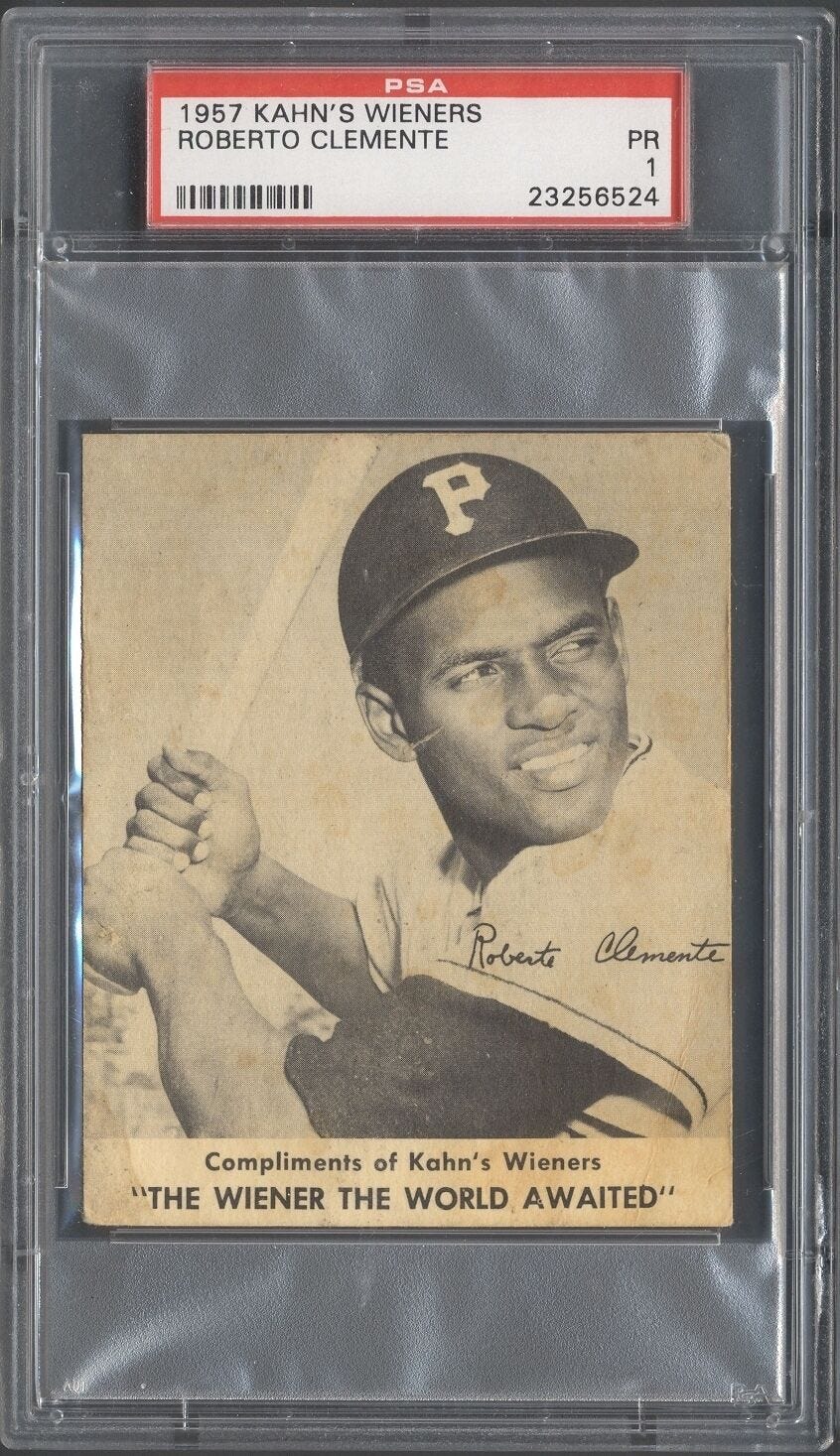When you click on links to various merchants on this site and make a purchase, this can result in this site earning a commission. Affiliate programs and affiliations include, but are not limited to, the eBay Partner Network.
Roberto Clemente is one of the most revered athletes of all time. It’s not just because he was a great baseball player. He was also a humanitarian, unabashedly proud of his heritage, and he cared about people.
Clemente played 18 years for the Pittsburgh Pirates. He had a .317 career batting average, led the league in average four times and had exactly 3,000 hits.
The Puerto Rican-born player was known for his charity work. He offered tips to kids on baseball, was a champion for the Latin American community and did what he could to help others.
Clemente was hope. He was inspiration. He was a hero.
He died in 1972. Just 38 years old.
Clemente died in a plane crash on New Year’s Eve. The plane was headed to Nicaragua to bring aid to earthquake victims, but shortly after takeoff, the plane crashed.
Fans continue to adore Clemente, a magnetic player who helped bring two World Series titles to Pittsburgh. It’s not surprising that many fans have collected his cards, and they have become some of the most popular cards of his era – even if Topps tried to change his name.
On several of Clemente’s Topps cards, his name was written as “Bob” instead of Roberto. Some media outlets also referred to him by this unasked-for nickname. However, Clemente was having none of it and he told media and anyone who asked that his name was Roberto.
On September 9, 2020, MLB celebrated Roberto Clemente Day with a number of players around the league donning Clemente’s No. 21, including all Pirates players and coaches.
In celebration of Clemente’s life and legacy, here’s a look at some of Clemente’s most popular and sought-after cards.
A time capsule into the hobby’s early days
By Dan Good
The pages are yellowed and faded, and the publications are long gone, but the stories are timeless — collectors in search of treasure.
It’s fascinating to go back and read hobby publications from the 1970s and early 1980s. Back issues of publications like “The Trader Speaks” and “Sports Scoop” represent time capsules of early card shows and collecting trends of yesteryear, a time before junk wax when the hobby was more trusting and insulated and still establishing standards. Some trends have stood the test of time. Others haven’t — there’s not a ton of interest in 1981 Donruss or Fleer error cards these days. But flipping through the magazine pages reveals how early sports card enthusiasts informed our collectibles knowledge and helped to change the hobby.
Prices were more reasonable.
In a 1971 issue of “The Trader Speaks,” SFC William Van Buskirk — a prominent autograph collector of the era — was selling a handful of items, including an official American League baseball signed by Babe Ruth, Lou Gehrig, Joe McCarthy, Bill Dickey, Charles “Red” Ruffing, Tony Lazzari, Dixie Walker, and 15 other members of the 1931-33 New York Yankees. The price? $125, or a little over $800 today. Which isn’t that far off from what some people have been paying on the secondary market for Topps Chrome Ben Baller boxes.
Meanwhile, in the early 1980s, 1951 Bowman Mickey Mantle (VG+) were going for $175 ($500 today) and 1953 Topps Mantles were going for $100 (about $300 today). Those items have become a bit more valuable in the ensuing years.
Vintage was still (mostly) affordable.
Many collectors are priced out of aspects of the hobby today — and not just high-end new releases. For example, collecting a partial set of 1952 Topps on a budget is all but impossible. I started to buy up low- to mid-grade commons a few years ago, given the set’s impact and beauty, but I stopped after acquiring 20 or 30. Obviously Mickey Mantle’s card is a big ticket item, but it’s a heavy burden for a casual collector to spend $1,000 or more on multiple star cards. You want to buy a Jackie Robinson that looks like it hasn’t been run over by a freight train — but it might cost a week’s worth of pay to get it. Same with Willie Mays, and Andy Pafko, and Yogi Berra...
And T206 … forget it! There was a time when you might be able to chip away at commons for a few dollars apiece, and then spend $50 or $100 for the key cards, and then remain persistent and cross your fingers on a Honus Wagner becoming available, but today, you might need hundreds of thousands of dollars to collect the non-Wagners in passable condition. No, I’ll appreciate the mid-grade Barney Pelty vertical I picked up 20 years ago for $30 and tip my cap to anyone attempting to collect a T206 these days.
Maybe we know too much about the hobby today. Maybe the secret’s out. It all comes down to supply and demand, and on key sets, demand outweighs supply. T206 and 1952 Topps are obviously extreme examples, iconic releases. But even less familiar sets have become pricey. I’ve been drawn in by Dixie Lids lately, specifically the 1952-54 lids that showed images of baseball players whenever someone opened their container of ice cream. Common lids from 1952 in any condition can cost more than $200 due to scarcity … it’s damn near impossible, unless you’re setting aside more than $10,000 and a decade of your life, or waiting for someone else to sell their collection, to complete a set of the lids.
You were bound to learn something new.
Before picking up a copy of The Trader Speaks, you might not know that “Fan Craze” playing cards were popular at the turn of the 1900s (Topps highlighted the cards in 2008 “Trading Card History,” as did Panini in 2014 Golden Age). Or that Bell Brand Chips released two sets of Lakers basketball cards in 1960 and 1961 that are quite rare. Back then, regional releases were just that — regional. And if you lived somewhere else in the country, you might otherwise miss them. Early card magazines were guaranteed to teach you something you didn’t know about a set you probably never knew existed. Where Beckett magazines of today include pricing information for recent releases from major brands, the magazines provided a window into what collectors were interested in, from media guides to La Pizza Royale Expos cards, which sounds like an imaginary restaurant franchise, and in fact, it was — the set was created by collector Bob Solon and friends, and had nothing to do with pizza. How prolific.
Confusion still reigned.
Without access to internet auction results and Worthpoint and Net54 message boards, collectors were left grasping about elements such as set checklists that are now more readily available (although still not always clear with many vintage sets). In those early days, experts might spend years studying a product before understanding it, visiting libraries and faraway locations and consulting with fellow collectors and interviewing former company employees, reconstructing checklists from scratch and uncovering rare variations. With today’s cards, the odds and details are readily available, if not from companies before a product’s release, then within days of casebreakers opening a product.
Connections were crucial.
It’s thrilling to read accounts of the early years, when major collectors would be on the lookout for the next lot, and send cards back and forth to each other through the mail, or happily share duplicates with other collectors who might need them. There was a collegial aspect to the hobby. Collectors helped each other. And it was special to meet up, not unlike at the National of today. “I’ll have to say this is the biggest thrill — to meet these old cronies of the pasteboard world face to face,” early collector Ray Hess wrote in a 1974 issue of “Sports Scoop,” a gem of a publication that lasted for two years. “You just never have enough time to visit and recall all the fond memories of years ago.”
Hobby heavyweights stood large.
You flip through the pages of an early publication, and you’re drawn in by the names — these are the people who built this hobby into what it is today. Jefferson Burdick was the pioneer of card collecting, no doubt, but other early contributors followed in shaping the hobby into something for the public to enjoy. There’s Preston Orem, a historian of early baseball … correspondence with “that great guy” Lionel Carter, “who I think invented the hobby,” according to Hess … flipping cards in the basement of Frank Nagy, known affectionately as “Mr. Baseball Card” … Dan Dischley, the editor and publisher of the Trader Speaks … Jim Nowell planning the West Coast convention, and Lloyd Toerpe following with a convention for the the Midwest … Jack Smalling collecting autograph after autograph … Bill Haber, whose hobby role stretched far beyond his job at Topps … Ed Broder and his California focus … Mike Berkus weighing in on the latest set … Bill Mastro and Robert Lifson advertising their vintage cards at the national convention … and so many others … and then there’s “A genuine scoop for Sports Scoop,” published in May 1974 by an intrepid young writer named Keith Olbermann, about the “Washington Nat’l Lea.” variations in that year’s Topps product. “It has been rumored that Topps prepared Padre cards with the Washington team label just in case, but apparently Topps accidentally, or intentionally, released these ‘proofs,’ at least in the South Florida area, where I vacationed in March,” Olbermann wrote. Many of the hobby pioneers are gone, while others have left the hobby or sold their collections, but that Olbermann fellow remains a significant presence.
Beckett wasn’t first.
As a collector from the 1990s, it’s easy to look at Beckett as the first and last name in the hobby — Beckett publications and price guides and grading have had a massive impact. But other publications (including Card Collector's Bulletin and Ball Card Collector, to name two) preceded Beckett.
The thrill of the chase hasn’t changed.
You go through a stack of cards, considering which ones you might want to add to your collection. You study the centering and condition, looking for surface creases or corner wear. Whether you collect by team, player or set, or maybe just casually, the elements of collecting are pretty much the same they were in the hobby’s early days.
Yesterday’s classified ads are today’s hobby Twitter.
If your messages cost five cents a word, or 20 cents a word, what would you write? How much space would you use? Which cards would you wish to buy and sell? What collecting needs would you highlight?
#CardChat: It’s football season!
With the start of the NFL season tonight, this week’s #CardChat on Twitter focused on football cards and collections. Join the chat every Wednesday at 8 p.m. E.T.
Here are this week’s highlights:







Trading Card News Round Up
Forbes: How Blake Jamieson Expanded His Art Empire from Topps Project 2020 Baseball Cards
Heartbreaking Cards: Schrodinger’s Cat of Trading Cards are Can You Really Have a Mint Topps Finest Card from the ‘90s?
Dime Boxes: Back in the Club


















